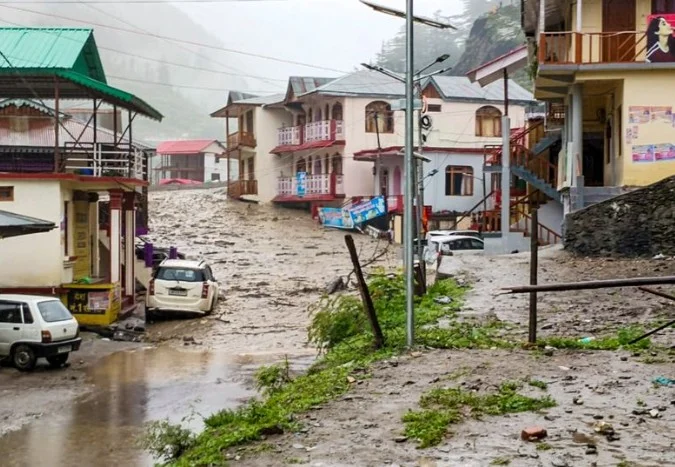Shimla/Dehradun, 6 August — Nowhere is the impact of climate change more acute than in the Himalayan states of Himachal Pradesh and Uttarakhand, where the terrain itself is crumbling under the weight of extreme weather events, glacial retreat, and ecosystem breakdown.
Over the past decade, both states have become ground zero for climate-induced disasters—from flash floods and glacial lake outbursts to landslides and prolonged dry spells. “The Himalayas are warming faster than the global average, and that is directly impacting the lives and livelihoods of the people here,” said a senior official from the India Meteorological Department (IMD).
Situated in one of the youngest and most geologically unstable mountain ranges in the world, Himachal Pradesh and Uttarakhand are uniquely vulnerable. The steep slopes, high altitude, and fragile ecology have always made them susceptible to natural disasters—but climate change is pushing the region to the edge.
Rising temperatures are rapidly shrinking glaciers like Gangotri and Yamunotri, which feed major rivers and support millions. Biodiversity is also under threat as temperature zones shift and ecosystems fail to adapt. “Even a slight shift in the climatic band can drive entire species out of existence or force them uphill,” noted ecologist Dr. Arvind Thakur.
Rainfall patterns have grown more erratic, marked by intense cloudbursts and flash floods followed by extended dry spells. Himachal Pradesh recorded 55 flash floods, 28 cloudbursts, and 48 major landslides since June 20 this year, resulting in at least 108 deaths and damages of ₹1,852 crore, according to government figures.
“This year, the rain came fast and furious. It overwhelmed our drainage systems and tore through the mountains,” said Ramesh Thakur, a resident of Mandi, one of the worst-hit districts. In August, a flash flood in Uttarakhand wiped out a village, killing at least four people and leaving over 50 missing.
Land destabilisation is also becoming a tragic hallmark of the region. In Joshimath last year, large cracks developed in homes and roads, forcing the evacuation of nearly 200 people. Experts have repeatedly warned that rampant construction and deforestation are amplifying the impact of extreme weather events.
Melting glaciers not only shrink vital water sources but also give rise to dangerous glacial lakes, which can burst without warning. The Chamoli disaster in February 2021, which killed over 200 people, was likely caused by a glacier collapse that unleashed a devastating flood in the Dhauliganga valley, destroying hydropower infrastructure in seconds.
Similar risks loom in Himachal’s Chandra basin and other high-altitude regions. “The Himalayas are full of ticking time bombs. Any glacial lake that breaches can bring disaster downstream within minutes,” warned glaciologist Dr. Meenakshi Rana.
The Himalayan region is seeing less snowfall and earlier snowmelt each year, disrupting agriculture, tourism, and hydropower. “Ski resorts in Manali are facing shorter seasons, and that affects the entire winter economy,” said a local tour operator.
In Himachal’s apple belt, the effects are particularly pronounced. Farmers report up to 30 percent decline in yields over the past decade due to reduced chilling hours needed for fruit setting. “The trees are flowering early, but the fruit doesn’t develop properly,” said orchardist Rajiv Chauhan from Shimla.
A trail of recent disasters
The scale and frequency of recent calamities paint a grim picture:
- In July 2025 alone, Himachal suffered over 100 weather-related deaths, while 1,738 homes were damaged across the state.
- On August 5, a flash flood swept through a village in Uttarakhand, killing four and leaving dozens missing.
- In November 2023, 41 workers were trapped in a collapsed tunnel in Uttarakhand—many were migrants from India’s poorest states.
- A month earlier, a glacial lake outburst in Sikkim led to floods that killed 179 people.
- In January 2023, land subsidence forced mass evacuations in Joshimath.
- And in June 2013, the Kedarnath floods claimed at least 580 lives, with nearly 6,000 reported missing in one of India’s worst natural disasters.
These events, experts say, are no longer isolated incidents but part of a pattern driven by global climate shifts combined with aggressive and often unregulated development in ecologically sensitive zones.
“There needs to be a complete rethinking of how we build, farm, and live in the mountains,” said Dr. Rana. “Without urgent mitigation and adaptation strategies, the Himalayas will continue to suffer—and so will the millions who depend on them.”
As the planet continues to warm, the question is no longer whether the Himalayas will face more disasters—but how often, how deadly, and how prepared the region will be.

